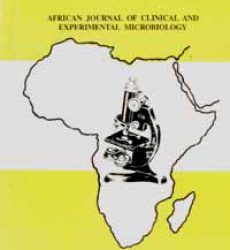Abstract
Background
Antibiotics have proven to be a dynamic category of drugs in the fight against infectious bacteria. However, antibiotic
resistance is one of the greatest current challenges to the effective treatment of infections and there is every indication that
antibiotic resistance will become an even greater challenge in the future.
Methodology
Ten clinical samples with varying frequencies were analyzed for bacterial growth, antibiotic susceptibility testing and
multiple antibiotic resistances. The clinical samples includes; urine (42%), wound swab (21.33%), blood (10%), ear swab
(9.33%), catheter tip (5.33%), endocervical swab (4.67%), high vaginal swab (HVS) (2.67%), urethral swab (2.67%), pus
(1.33%) and antral aspirate (0.67%).
Results
A total of 150 bacterial isolates distributed among these ten (10) clinical samples were identified, of which Staphylococcus
aureus (30%) was the most predominant, while Klebsiella oxytoca, Citrobacter spp. and Streptococcus spp. were the least
(0.67%). These were tested for sensitivity against 9 antibiotics. The resistance rate observed was as follows; cefuroxime
(93%), ceftazidime (87%), gentamycin (79%), augmentin (70%), cloxacillin (67%), ofloxacin (54%), ciprofloxacin (51%),
ceftriaxone (38%) and ocefix (34%). One hundred and forty-three (95.3%) of the isolates showed multiple resistance against
3 – 8 antibiotics. None was resistant to as few as 1 – 2 antibiotics.
Conclusion
The high susceptibility to some antibiotics such as ceftriaxone and ocefix could be a welcoming relief, since they can be
used to address the problem of resistance in this area. There is need for nationwide surveillance programme to monitor
microbial trends and antimicrobial resistance patterns in Nigeria.
Key words: multi-drug resistant, clinical samples, Staphylococcus aureus, ocefix.
Contexte
Les antibiotiques se sont démontrés être une catégorie dynamique des médicaments pour lutter contre les infections
bactériennes. Cependant, la résistance aux antibiotiques est l’un des grands défis actuels pour le traitement efficace des
infections et tout porte à croire que la résistance aux antibiotiques devient un défi encore plus grand à l’avenir.
Méthodologie
Dix échantillons cliniques avec leurs grandes fréquences ont été analysés par la culture bactériennes, le teste de sensibilité
aux antibiotiques et le teste de la multirésistance aux antibiotiques. Les échantillons cliniques sont constitués de l’urine
(42%), de pus de la plaie (21,33%), de sang (10%), de prélèvement d’oreille (9,33%), d’extrémité du cathéter (5,33%), de
prélèvement d’endocervical (4,67%), de prélèvement vaginal (2,67%), de prélèvement urétral (2,67%), de pus (1,33%), de
ponctionantrale(0,67%).
Résultats
Au total, 150 souches bactériennes réparties parmi les dix (10) échantillons cliniques ont été identifiées, parmi lesquelles
Staphylococcus aureus (30%) était le plus prédominant, alors que Klebsiellaoxytoca,Citrobacter spp et Streptococcus spp
étaient les moindres (0,67%). Ils ont été testés pour la sensibilité de 9 antibiotiques. Le taux de résistance observé était le suivant: céfuroxime (93%), ceftazidime (87%), gentamicine (79%), augmentin (70%), cloxacilline (67%), ofloxacine (54%),
ciprofloxacine (51%), ceftriaxone (38%) etocefix (34%). Cent-quarante-trois (95,3%) d’isolats ont montré la multi-résistance
contre 3 à 8 antibiotiques. Aucune souche n’a été résistante à moins de 1 à 2 antibiotiques.
Conclusion
La forte sensibilité de certains antibiotiques tels que la ceftriaxone et l’ocefix pourraient être un ouf de soulagement, car ils
peuvent être utilisés pour résoudre le problème de la résistance dans cette région. Il est nécessaire pour le programme
national de surveillance pour suivre les tendances microbiennes et les situations de résistance aux antimicrobiens au
Nigeria.
Mots clés: multi-résistance aux antibiotiques, échantillons cliniques, Staphylococcus aureus, ocefix.
Article in English.
Download full journal in PDF below

